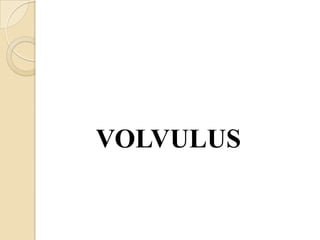
Volvulus
- 1. VOLVULUS
- 2. PRESENTATION OUTLINE Definition Causes Incidence Pathophysiology Clinical features Diagnostic investigation Predisposing factors Nursing intervention
- 3. OUTLINE CONT’ Treatment Pre-Operative Care Post Operative Care Complications Care plan (Nursing Diagnosis and outcomes) References
- 4. VOLVULUS It is the term applied to twisting of a loop of bowel so that the mesenteric vessel and the lumen of the bowel become occluded. It therefore is an obstruction of the bowel.
- 5. Volvulus Obstruction caused by twisting of the intestines more than 180 degrees about the axis of the mesentery 1-5% of large bowel obstructions ◦ Sigmoid ~ 65% ◦ Cecum ~25% ◦ Transverse colon ~4% ◦ Splenic Flexure
- 6. TYPES OF VOLVULUS Volvulus neonatorum Volvulus of the small intestine Ceacal volvulus (volvulus of the caecum) Sigmoid volvulus (which is most common and responsible for most intestinal obstruction) Gastric volvulus
- 10. Sigmoid Volvulus
- 11. CAUSES No actual cause is known but certain predisposing conditions which results or complicates into volvulus will be discussed in subsequent slides.
- 12. PREDISPOSING FACTORS Person’s with a redundant colon One with a normal anatomic variation resulting in extra colonic loops Patients with muscular dystrophy due to the smooth muscle dysfunction Congenital intestinal malrotation Abnormal intestinal contents e.g. meconium ileus or adhesions
- 13. PREDISPOSING FACTORS TO GASTRIC VOLVULUS CONT’ Abnormalities of adjacent organs like: Diaphragm (hernia, rupture, nerve palsy) Liver (dislocation) Spleen (splenomegaly, wandering spleen, polyspenia)
- 14. INCIDENCE Occurs commonly in middle aged and elderly people especially in men.
- 15. PATHOPHYSIOLOGY The sigmoid colon twists upon itself resulting in the intestinal obstruction (vovulus) which could be: Acute (total vascular impairment) Sub-acute (without vascular impairment) Chronic (twisting occurs followed by a correction but twisting reoccurs this time to form a double knot known as ileosigmoid knotting which involves the sigmoid colon and ileum.
- 16. CLINICAL FEATURES Abdominal distension and vomiting Ischemia (loss of blood flow) to the affected portion of intestine Absolute constipation There may be visible peristalsis as well as features of peritonitis Severe pain and progressive injury to the intestinal wall
- 17. CLINICAL FEATURES CONT’ Accumulation of gas and fluid in the portion of the bowel Necrosis of the affected intestinal
- 18. DIAGNOSTIC INVESTIGATIONS This includes: An Upper GI series (the use of barium meal swallow to perform a GIT radiography) A Digital rectal examination with rectal tube And the taking of a straight x-ray film of the abdomen
- 19. Barium Enema
- 24. NURSING INTERVENTION Administer analgesics required to client to ease off pain Encourage client to avoid copious foods that will induce vomiting Give anti-emetics prescribed. IV fluid administration is done to replace body fluids and prevent acidosis by maintaining electrolyte balance.
- 25. NURSING INTERVENTION CONT’ Examine abdomen for distension and tenderness Auscultate for bowel sounds and movements
- 26. TREATMENT This is a surgical intervention done by untwisting the gut in a procedure called sigmoidoscopy (sigmoidoscopic reduction) Also laparotomy can be done to have a sigmoid resection or untwisting Incision into the abdomen to untwist the knot (volvulus) and possibly resecting any unsalvageable portion
- 27. Operative management for sigmoid volvulus Elective resection ◦ Same admission Emergent laparotomy ◦ Operation depends on viability of the bowel Resection and anastomosis Hartmann resection Exteriorization resection Detorsion Detorsion with colopexy Percutaneous colostomy Percutaneous sigmoidpexy
- 28. PRE-OPERATIVE ACTIVITIES Explain procedure to client and relief of psychological stress Skin preparations e.g. Shaving the abdomen Give patient a low residue diet to have less stools formed Antibiotic administration 3-5 days before surgery in an attempt to decrease the bacteria of the bowel content with the aim of decreasing wound infection. E.g. include neomycin, streptomycin, etc
- 29. PRE-OPERATIVE ACTIVITIES CONT’ A nasogastric or intestinal tube is inserted before operation and connected to a suction machine to clear the intestinal contents.
- 30. POST OPERATIVE ACTIVITIES Until peristalsis return, anything to be given is introduced parenteral Moisten mouth with clean water as a result of dryness created by anaesthetic agent All fluids given as infusions should be recorded Catheterize patient to ease difficulty in voiding and to prevent urine retention
- 31. POST OPERATIVE ACTIVITIES CONT’ Give opiod analgesics to relieve pain Encourage patient to do deep breathing and to change position every 1 hour Manage rectal tube sutured in the anus to facilitate the passage of stool Drugs such as neostigmine is given to prevent straining the intestine during expulsion Early ambulation to start peristalsis
- 32. COMPLICATIONS A serious condition that could result in death especially in the acute type of volvulus.
- 33. NURSING DIAGNOSIS Pain in patient related to bowel obstruction High risk for fluid volume deficit related to fluid shifts and losses from vomiting. Fear and anxiety of patient and family related to undergoing invasive procedures
- 34. EXPECTED OUTCOMES Pain will subside in 3-5 hrs as normal peristaltic movements returns to normal and allow oral intake of foods Patient will maintain a normal electrolyte balance and skin turgor within 24 hrs. Fear and anxiety will be alleviated by making client have the confidence and conviction that all will be well.
- 35. REFERENCES Colmer. M.R. Moroney’s Surgery for Nurses, London: Churchil Livingston. Bloom. , A and Bloom, S.R. Toohey’s Medicine for Nurses, London: churchil Livingstone Reynolds Watson, J.E., Watson’s Medical- Surgical Nursing and Related Physiology, London: Baillierre Tindall.
Notas do Editor
- Longitudinal axis extend from gastroesophageal junction to the pylorusThe stomach may rotate on a longitudinAal axis that extends from the gastroesophageal junction to the pylorus.Rotation about this axis causes the greater curvature of the stomach to rest superior to the lesser curvature, resulting in an “upside-down” stomach. This is called “organoaxialvolvulus”.
- Mesenteroaxial axis extends from greater to lesser curvature of stomachCauses complete obstructionRotation of the stomach along an axis perpendicular to its longitudinal axis is called “mesentero-axial volvulus”
- Rotation of the stomach about both the organoaxial and mesenteroaxial axes is termed “combined volvulus”.